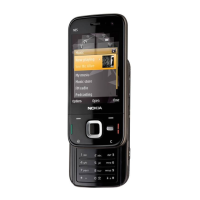
 Loading...
Loading...
Do you have a question about the Nokia N85 and is the answer not in the manual?
| Display diagonal | 2.6 \ |
|---|---|
| Display resolution | 320 x 240 pixels |
| Display number of colors | 16.78 million colors |
| Ringer type | Polyphonic |
| Voice recording | Yes |
| Phonebook capacity | 1500 entries |
| Internal memory | 74 MB |
| Sensor type | CMOS |
| Digital zoom | 8 x |
| Rear camera type | Single camera |
| Video capture resolution (max) | 640 x 480 pixels |
| Headphone connectivity | 3.5 mm |
| USB 2.0 ports quantity | 1 |
| Multimedia Messaging Service (MMS) | Multimedia Messaging Service (MMS) is a standard way to send messages that include multimedia content to and from a mobile phone over a cellular network |
| Gaming time | 7 h |
| Browsing time | 5.8 h |
| Talk time (2G) | 6.9 h |
| Battery capacity | 1200 mAh |
| Standby time (2G) | 363 h |
| Personal info management (PIM) | Alarm clock, Calculator, Calendar, Notes, To-do list |
| Form factor | Slider |
| Product color | Black |
| 2G standards | EDGE, GPRS |
| Data network | wcdma |
| Bluetooth version | 2.0+EDR |
| Depth | 50 mm |
|---|---|
| Width | 103 mm |
| Height | 16 mm |
| Weight | 128 g |
Details on regular and USB charging methods, including tips for battery care.
Information on obtaining new features, performance improvements, and software updates.
Information on PIN, PUK, and lock codes for device and SIM card security.
Tips and methods to conserve battery power and extend battery life on the device.
Guidance on viewing memory usage and freeing up space by removing unnecessary data.
Explains how to activate the offline profile to use the device without wireless network connectivity.
Step-by-step guide on how to access and navigate web pages using the browser.
Information about supporting wireless local area network (WLAN) for internet access.
Information on wireless connections to compatible devices like phones and headsets.
Steps for transferring files and data to other compatible devices via Bluetooth.
Instructions on pairing the device with other compatible Bluetooth devices.
How to accept and manage incoming data received via Bluetooth.
How to customize themes, wallpapers, and icons for the device display.
How to customize ringing tones, alerts, and other sounds using profiles.
Explains the Global Positioning System (GPS) and its functionality in the device.
Details on using A-GPS for faster and more accurate location calculation.
How to start and use the route guidance feature for navigation.
Overview of the Maps application's features like location viewing and route planning.
How to navigate maps, view current location, and handle automatic map downloads.
Information on automatically downloading maps and preventing charges.
PC software for downloading and installing maps and voice files onto the device.
Steps to plan routes to destinations and add multiple locations.
Instructions on purchasing and using navigation services with voice guidance.
How to purchase and use turn-by-turn navigation for driving.
How to start navigation to a destination and use navigation options.
Overview of the music player, supported formats, and basic playback functions.
Step-by-step guide on selecting and playing music tracks or podcast episodes.
How to view, manage, and create playlists for music tracks.
Information on accessing and managing podcasts available on the device.
Methods for transferring music files from a PC or other devices.
Explains using mass storage or Windows Media Player for PC music transfer.
Information on searching, browsing, and purchasing music from the Nokia Music Store.
Information about the FM transmitter feature for playing device audio through FM receivers.
Explains the availability, operation, and limitations of the FM transmitter feature.
Step-by-step instructions for playing songs through a compatible FM receiver.
Overview of the Podcasting application for downloading and managing podcasts.
How to search for podcasts by keyword or title using the built-in search engine.
Accessing FM radio, Visual Radio, and Internet radio services.
Using the device as a traditional FM radio for tuning and saving stations.
Instructions on how to listen to FM radio, including saving stations and using the loudspeaker.
Listening to radio stations available on the internet via WLAN or packet data.
Steps for selecting and listening to internet radio stations.
Overview of the device's dual cameras, image resolution, and video recording capabilities.
How to open the lens cover or use the capture key to activate the camera.
Information on capturing still images, including camera indicators.
Step-by-step guide on how to capture still images using the device's camera.
Options available after capturing an image, such as saving, sending, or setting as wallpaper.
Instructions for capturing multiple images quickly or at defined intervals.
Advice on improving photo quality, background composition, depth, and lighting.
Information on recording videos, including capture indicators and file types.
Step-by-step guide for recording videos, including pausing and stopping.
Options available after recording a video clip, such as playing, deleting, or sending.
How to adjust setup and main settings for the camera.
Configuration options for image quality, location recording, and zoom.
Settings for video quality, GPS location recording, and video stabilisation.
Overview of the Photos application for viewing and managing images and videos.
How to view all captured, downloaded, or received images and video clips.
Accessing the image editor for cropping, rotating, and applying effects.
Editing video clips by merging, adding sound, text, or cutting sections.
Printing images using Image print via USB, Bluetooth, or wireless LAN.
Using the Image print feature to print images from Photos, camera, or editor.
Uploading photos and videos to online albums or weblogs.
Explains compatibility with UPnP/DLNA, creating a home network, and sharing media.
Security advice for configuring WLAN home networks and protecting passcodes.
Steps to configure WLAN access points and home network settings.
Allowing or denying sharing of media files and defining content for sharing.
Sharing media files with other UPnP devices and viewing files stored on the device.
Synchronizing media files between the mobile device and home devices.
Steps to set up and perform media file synchronization.
Downloading and streaming video clips from internet services or transferring from PC.
Browsing video content, selecting clips, and viewing clip details.
Transferring video clips from a PC to the device using a USB data cable.
Introduction to N-Gage as a mobile gaming platform for downloading and playing games.
Instructions on registering for a new N-Gage player name and personalizing the profile.
How to start playing or resume a game, including options for paused games.
Managing downloaded and installed games, including different game types (full, trial, demo).
Overview of the messaging interface, its folders, and creating new messages.
Using traditional and predictive text input methods for writing messages.
Using the built-in dictionary for faster text entry with single keypresses.
Creating and sending text, multimedia (MMS), and e-mail messages.
Receiving and viewing messages, including unread indicators.
Handling multimedia messages, including retrieving, viewing, and playing content.
Managing e-mail accounts and settings for retrieving messages.
Configuring mailbox settings, including access points and e-mail protocols.
Retrieving new, selected, or all e-mail messages from a remote mailbox.
Deleting e-mail messages from the device or from both the device and server.
Configuring settings for text messages, including message centres and character encoding.
Settings for multimedia messages, such as image size and MMS creation mode.
Managing mailboxes, connection settings, user details, and retrieval options.
Creating, removing, and configuring individual mailbox settings.
Setting up automatic retrieval of e-mail headings and notifications.
Making and ending voice calls, including international calls and call from contacts.
Features available during a call, such as sending images, holding calls, and using DTMF tones.
How to answer, decline, mute, or silence incoming calls.
Initiating and managing conference calls with multiple participants.
Using voice commands to initiate calls and control device functions.
Making calls using voice tags assigned to contacts.
How to make video calls, including requirements and call handling.
Managing video call display, camera usage, snapshots, and quality settings.
Handling incoming video calls, including answering, declining, or replacing video.
Sending live video or clips to another device during a voice call.
Explains UMTS connection and person-to-person connection requirements for video sharing.
Steps to share live video or recorded clips during a voice call.
Information on making and receiving calls over the internet via VoIP or mobile phones.
Steps to activate internet call services and configure connection settings.
How to make internet calls from various applications and the standby mode.
Configuring service connectivity, availability requests, and advanced settings.
Adding new contacts, filling fields, and editing existing contact cards.
Adding contacts to groups, checking group belonging, and deleting contacts.
Restricting outgoing calls to specific numbers and activating/deactivating fixed dialling.
Playing video clips and streaming media files using RealPlayer.
Selecting and playing saved media files, including recently played files.
Streaming media content over the internet using access points.
Recording voice memos and telephone conversations using the device.
Managing alarms, setting time, date, and updating time zones automatically.
Setting, managing, and turning alarms on/off, including snooze functionality.
Creating calendar entries, setting reminders, and managing appointments.
Step-by-step guide to adding new entries like meetings, memos, and anniversaries.
Deleting multiple calendar events and marking tasks as completed.
Overview of Quickoffice applications for viewing documents and downloading software.
Viewing Microsoft Word documents (.doc, .txt) on the device.
Viewing Microsoft Excel files (.xls) on the device.
Viewing Microsoft PowerPoint presentations on the device.
Using the device's calculator for basic arithmetic operations.
Viewing installed applications, removing them, and managing installation settings.
Transferring and installing applications from various sources, including PC and messages.
Uninstalling applications and software, and managing reinstallation.
Browsing, managing, and opening files on the device, memory card, or external drives.
Synchronizing notes, calendar entries, messages, and contacts with computers or the internet.
Customizing display, standby mode, and general device functions.
Managing PIN codes, lock codes, keypad autolock, and SIM card security.
Settings related to phone and SIM card security, including PIN requests and lock code changes.
Configuring positioning methods like GPS, A-GPS, and Bluetooth GPS.
Editing settings related to voice calls and network, including caller ID and call waiting.
Editing settings related to voice calls and network, including caller ID and call waiting.
Understanding packet data connections, access points, and MMS access points.
Creating and managing internet access points (IAPs) for various services.
Step-by-step guide to creating a new internet access point.
Creating and configuring WLAN internet access points with security settings.
Details about the rechargeable battery, compatible chargers, and battery care.
How to verify the authenticity of Nokia batteries using hologram labels.
Information on potential interference between wireless devices and medical equipment.
Recommendations for maintaining separation distance between wireless devices and implanted medical devices.
Precautions for using the device in areas with potentially explosive atmospheres, like refuelling stations.
Instructions on how to make emergency calls, including device readiness and network requirements.